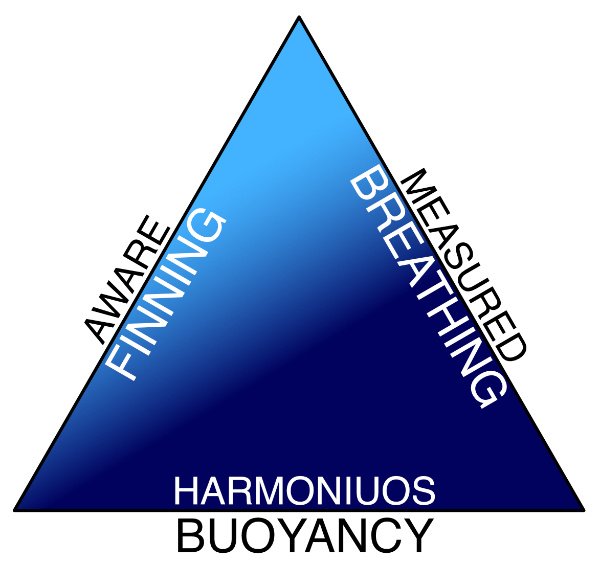The triangle of skills
To obtain quality underwater footage, relying solely on a good video camera is not enough. Instead, it becomes fundamental to master the “triangle of skills,” three competencies I have identified that are closely interconnected: harmonious (or impeccable) buoyancy, which allows for stability and control; conscious finning, to move gracefully and without disturbing the environment; and finally, measured, calm, and controlled breathing, which influences every other aspect.
These three elements are the practical foundations upon which every videomaker should build their filming capabilities.


Dangerous Reef, St. John’s, Egypt 2023 with GoPro12, 8:7, 4K, 60fps
Harmonious buoyancy
Buoyancy control is fundamental for reducing air consumption, increasing personal safety, and, above all, ensuring the utmost respect for the environment. Good neutral buoyancy, which allows for fluid movement and the ability to remain motionless in the water, enables more stable footage and the ability to approach animals without disturbing them or stirring up sediment.
For this reason, it is important to remember that the BCD is intended exclusively for coarse buoyancy adjustments: for example, to initiate descent (by deflating it), at the end of the ascent to achieve good surface flotation (by inflating it), or to compensate at depth for neoprene compression and, towards the end of the dive, the increased positive buoyancy due to the lightening of the tank. Small vertical variations, however, must be managed solely with breathing. Constant practice and specific exercises are the key to refining this skill.
Aware finning
Good video recordings require valid and efficient finning. There are effective and environmentally friendly techniques that every underwater videomaker should know.
The most important is the Frog Kick: a powerful thrust achieved with minimal effort, which directs the water flow backward, thus avoiding stirring up sediment. When performing it, knees and ankles are slightly flexed, then heels and soles of the feet are brought together in a movement similar to that of the frog stroke; propulsion is mainly generated by the lower part of the leg (calves, ankles, and feet), with minimal involvement of the thighs.
To rotate on the spot and adjust framing, however, it is preferable to use the Helicopter Turn, during which the fins move in opposite directions thanks to specific ankle movements. A useful advanced technique is the Back Kick, which allows for gently moving backward without having to turn around, ideal after close-up shots or for exiting tight spaces.
The choice of fins is crucial and must be based on one’s finning style, as using an unsuitable model can cause cramps and fatigue.
South Sataya, Fury Shoals, Egypt 2023 with GoPro11, 8:7, 4K, 60fps
Myaru Kandu, Felidhoo, Maldives 2024 with GoPro12, 8:7, 4K, 60fps
Measured breathing
As we have seen, buoyancy variations, which are fundamental in video recording, are managed solely with breathing: by inhaling one ascends slightly, by exhaling one descends.
Calm and regular breathing transforms these micro-variations into fluid movements, ensuring perfect stability and thus avoiding shaky footage. During buoyancy micro-adjustments (both with the lungs and with the BCD), it is important to consider the hysteresis phenomenon: a sort of “memory” or “delay” effect of the system, which always requires a few seconds for the adjustment to complete. To avoid triggering a dangerous “inflate-deflate” cycle, it is crucial not to make closely spaced corrections, but always to wait for buoyancy to stabilize before intervening again.
Regarding filming, poorly controlled breathing generates voluminous and noisy bubbles, which can easily intimidate animals. Conversely, by breathing slowly and deeply, bubble production is significantly reduced, thereby increasing the chances of approaching subjects without disturbing their natural behaviors. Furthermore, measured and conscious breathing contributes to reducing air consumption, increasing safety, and allowing for prolonged bottom time.
